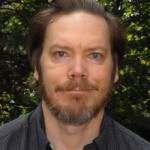 Prof Alan Wuosmaa has been awarded a grant for 3 years for Studies of exotic nuclei with transfer reactions. For the information about Prof. Wuosmaa research visit his home page.
Prof Alan Wuosmaa has been awarded a grant for 3 years for Studies of exotic nuclei with transfer reactions. For the information about Prof. Wuosmaa research visit his home page.
Posts related to particle and nuclear physics research
 Prof Alan Wuosmaa has been awarded a grant for 3 years for Studies of exotic nuclei with transfer reactions. For the information about Prof. Wuosmaa research visit his home page.
Prof Alan Wuosmaa has been awarded a grant for 3 years for Studies of exotic nuclei with transfer reactions. For the information about Prof. Wuosmaa research visit his home page.
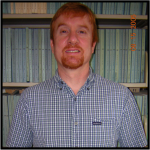 Professor Tom Blum has been selected a “Fermilab Distinguished Scholar”.
Professor Tom Blum has been selected a “Fermilab Distinguished Scholar”.
Fermilab Distinguished Scholars are rotating multi-year appointments for U.S. theorists in either the Fermilab Theoretical Physics Department or the Theoretical Astrophysics Group.
The Fermilab Distinguished Scholars program aims to:
For more information see Fermilab Distinguished Scholars Program
Muon g-2 Theory Initiative Hadronic Light-by-Light working group workshop
Workshop participants will discuss recent progress and plans to determine the hadronic light-by-light scattering contribution to the muon anomalous magnetic moment, which is expected to contribute the largest uncertainty in the Standard Model prediction. The goal of the workshop is to estimate current and expected systematic errors from lattice QCD, dispersive methods, and models and create a plan to address them in time for new experiments at Fermilab and J-PARC. For more information, please visit the workshop web site.
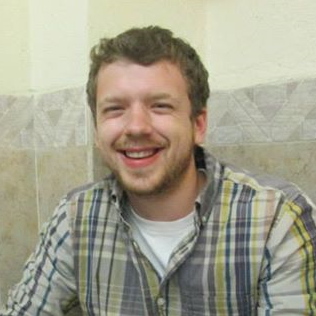
In May, 2017 UConn alumnus Alex Barnes was awarded a postdoctoral fellowship in Nuclear Physics at Carnegie Mellon University, working in the group of Prof. Curtis Meyer. Alex begins this appointment immediately after completing his PhD at the University of Connecticut in April 2017, under the guidance of Prof. Richard Jones.
In his new position, Alex joins a team of 5 other junior scientists working at Jefferson Lab on the analysis of data from the GlueX experiment. He also assumes shared responsibility for operation and calibration of the Central Drift Chamber, and other detector subsystems. In his PhD thesis, Alex showed that a clean sample of exclusive phi(1020) mesons could be reconstructed using the GlueX detector. With the addition of higher statistics data in 2018 and following, he plans to push his investigation into the higher mass region, in search of new exotic particles that are predicted to exist based on the Standard Model of strong interactions.
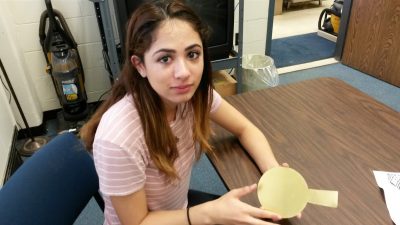 The U.S. Centers for Disease Control lists radon as a primary cause of lung cancer, second only to smoking. The Environmental Protection Agency estimates that 20,000 deaths each year from lung cancer in the U.S. are the result of exposure to radon in the living environment. It is believed that as many as 1 in 15 homes in the continental United States have radon levels that require some form of mitigation. In spite of this, very few homes are equipped with continuous radon monitoring devices and most radiation monitoring facilities only provide feedback on time scales of weeks or even months.
The U.S. Centers for Disease Control lists radon as a primary cause of lung cancer, second only to smoking. The Environmental Protection Agency estimates that 20,000 deaths each year from lung cancer in the U.S. are the result of exposure to radon in the living environment. It is believed that as many as 1 in 15 homes in the continental United States have radon levels that require some form of mitigation. In spite of this, very few homes are equipped with continuous radon monitoring devices and most radiation monitoring facilities only provide feedback on time scales of weeks or even months.
The technology used in standard residential radon monitoring has not changed significantly over the past 50 years. On the other hand, development of fast detectors for particle physics experiments at large international laboratories such as the Large Hadron Collider over the past two decades has opened up new technologies for radiation detection that may result in a significant improvement in the efficiency and response time for radon detection.
UConn undergraduate Mira Varma, pictured above, is holding a part of what she hopes to assemble into a hand-held radon detector capable of detecting changes in radon concentration on the time scale of an hour, close to the time scale of the natural variation in a residential environment, rather than days or weeks. Mira is carrying out this development under the direction of UConn Physics Prof. Richard Jones.
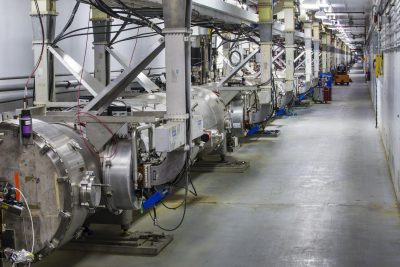
Scientists have been rigorously commissioning the experimental equipment to prepare for a new era of nuclear physics experiments. This equipment is at the newly upgraded Continuous Electron Beam Accelerator Facility (CEBAF) at Jefferson Lab in Newport News, Virginia. These activities have already led to the first scientific result. This research demonstrates the feasibility of detecting a potential new form of matter.
The result demonstrates the feasibility of detecting hybrid mesons. These mesons are particles that are built of the same stuff as ordinary protons and neutrons: quarks bound together by the “glue” of the strong force. But unlike ordinary mesons, the glue in hybrid mesons behaves differently. The research provides a window into how mesons and other particles that are smaller than atoms are built by the strong force. The study also offers insights into “quark confinement” — why no quark has ever been found alone.
The first experimental result has been published from the newly upgraded Continuous Electron Beam Accelerator Facility (CEBAF). The 12-GeV CEBAF Upgrade is a $338 million, multi-year project to triple CEBAF’s original operational energy for investigating the quark structure of the atom’s nucleus. The upgrade is scheduled for completion in the fall of 2017. This first result demonstrates the feasibility of detecting a potential new form of matter. It comes from the Gluonic Excitations Experiment, which is staged in the new Experimental Hall D that was built as part of the upgrade. GlueX collaborators are working to produce new particles, called hybrid mesons, which are particles in which both the quarks and the strong-force gluons have a role in the structure. Producing and studying the spectrum of these particles will provide nuclear physicists a window to “quark confinement” — why no quark has ever been found alone. Data were collected over a two-week period following equipment commissioning in the spring of 2016. The experiment produced two ordinary mesons called the neutral pion and the eta, and the production mechanisms of these two particles were carefully studied. The data provided powerful new information on meson production mechanisms, ruling out several, and the data also showed that the GlueX experiment can produce timely results.
Richard Jones
Group Leader, University of Connecticut
richard.t.jones@uconn.edu
This material is based upon work supported by the U.S. National Science Foundation under grant 1508238.
H. Al Ghoul, et al. (GlueX Collaboration), “Measurement of the beam asymmetry Σ for π0 and η photoproduction on the proton at Eγ = 9 GeV” Physical Review C 95, 042201 (2017). [DOI: 10.1103/PhysRevC.95.042201]
Symmetry magazine article: Exploring the universal glue
Jefferson Lab news release: Jefferson Lab accelerator delivers its first 12 GeV electrons
Jefferson Lab news release: Jefferson Lab accelerator upgrade completed: Initial operations set to begin while experimental equipment upgrades continue
This article first appeared under Science Highlights on the Dept. of Energy web site, October 6, 2017.
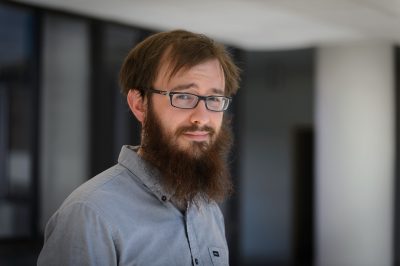
As a theoretical physicist studying the fundamental elements of matter, UConn graduate student Daniel Hoying creates calculations so large and complex they require supercomputers to perform them.
So Hoying is obviously excited that he will soon have regular access to one of the world’s most powerful supercomputers at the U.S. Department of Energy’s Brookhaven National Laboratory in Long Island, N.Y. The system is outfitted with Intel’s powerful new Knights Landing Xeon Phi chip. The chip’s 8 billion transistors and other cutting-edge technologies can carry the heavy processing loads that scientists like Hoying need to do their work.
“This represents an enormous opportunity for me,” says Hoying, who is headed to Brookhaven as a recipient of a U.S. Department of Energy (DOE) Office of Science Graduate Student Research (SCGSR) Award. “The level of precision offered by these processors allows us to make calculations that we would never have conceived of a few years ago. The on-site expertise can’t be discounted either. There are a lot of people there who know a lot of things I don’t know. It’s very exciting to have an opportunity to learn from them.”
Starting in July, Hoying will spend 12 consecutive months conducting part of his dissertation research at Brookhaven. Only 53 graduate students around the country received SCGSR awards this year. Other winners included students from Yale, Princeton, MIT, Duke, Cornell, CalTech, and Michigan State.
“The SCGSR program prepares graduate students for science, technology, engineering, or mathematics (STEM) careers critically important to the DOE Office of Science’s mission,” says Steve Binkley, acting director of DOE’s Office of Science. “We are proud of the accomplishments these outstanding students already have made, and look forward to following their achievements in years to come.”
Hoying’s research focuses on the Standard Model of particle physics. The Standard Model explains how the basic building blocks of matter interact and are governed by fundamental forces such as gravity and electromagnetism. It is the most fundamental theory of nature.
Hoying specifically studies the strong force in the Standard Model, otherwise known as Quantum Chromodynamics or QCD. The strong force binds fundamental particles of matter together to form larger particles. For example, the strong force helps quarks and gluons combine to make protons and neutrons, which in turn combine to make atoms, which in turn combine to make molecules and so on.
He is currently looking at the decaying cycle of particles known as kaons, which decay into two other particles called pions. These extremely small particles, first discovered in cosmic rays, only exist for fractions of a second and have been identified in experiments run in large particle accelerators. They are an essential part of the Standard Model of particle physics.
Previous calculations have shown that theory and experiments involving the decay of kaons have differed by small amounts. Hoying’s research aims to reduce those uncertainties, to help scientists learn more about what these particles are and how they behave.
Besides increasing understanding and advancing basic science, ultimately the information gathered through Hoying’s research could have a variety of applications in advanced computing and various energy fields.
“Dan is a talented young physicist who works hard,” says Professor Thomas Blum, Hoying’s advisor in the Department of Physics. “I’m fortunate to have him working for me.”
This article by Colin Poitras (UConn Communications) appeared in UConn Today on April 17, 2016.
Instead of directly searching for new particles as the LHC experiments are doing in Geneva, the muon g-2 experiment at Fermilab measures a well-known physical property of the muon to ever greater precision, looking for deviations from the value it should have based on the Standard Model of particle physics, assuming that no new forces or particles are in play. UConn theorists Tom Blum and Luchang Jin are contributing to this effort by reducing the theoretical uncertainty on the Standard Model prediction to match the anticipated experimental precision.
June 1, 2017
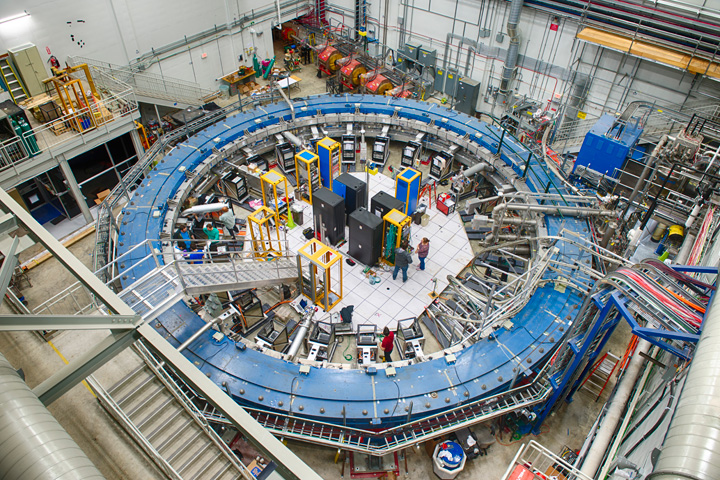 The Muon g-2 ring with instrumentation, awaiting muons at Fermi National Accelerator Laboratory. Credit: Fermilab
The Muon g-2 ring with instrumentation, awaiting muons at Fermi National Accelerator Laboratory. Credit: Fermilab
What do you get when you revive a beautiful 20-year-old physics machine, carefully transport it 3,200 miles over land and sea to its new home, and then use it to probe strange happenings in a magnetic field? Hopefully you get new insights into the elementary particles that make up everything. The Muon g-2 experiment, located at the U.S. Department of Energy’s (DOE) Fermi National Accelerator Laboratory, has begun its quest for those insights. On May 31, the 50-foot-wide superconducting electromagnet at the center of the experiment saw its first beam of muon particles from Fermilab’s accelerators, kicking off a three-year effort to measure just what happens to those particles when placed in a stunningly precise magnetic field. The answer could rewrite scientists’ picture of the universe and how it works.
“The Muon g-2 experiment’s first beam truly signals the start of an important new research program at Fermilab, one that uses muon particles to look for rare and fascinating anomalies in nature,” said Fermilab Director Nigel Lockyer. “After years of preparation, I’m excited to see this experiment begin its search in earnest.”
Getting to this point was a long road for Muon g-2, both figuratively and literally. The first generation of this experiment took place at the U.S. DOE’s Brookhaven National Laboratory in New York State in the late 1990s and early 2000s. The goal of the experiment was to precisely measure one property of the muon – the particles’ precession, or wobble, in a magnetic field. The final results were surprising, hinting at the presence of previously unknown phantom particles or forces affecting the muon’s properties.
Video depicting the first leg of the g-2 electromagnet’s 3,200-mile journey from Brookhaven to Fermilab
The new experiment at Fermilab will make use of the laboratory’s intense beam of muons to definitively answer the questions the Brookhaven experiment raised. And since it would have cost 10 times more to build a completely new machine at Brookhaven rather than move the magnet to Fermilab, the Muon g-2 team transported that large, fragile superconducting magnet in one piece from Long Island to the suburbs of Chicago in the summer of 2013.
The magnet took a barge south around Florida, up the Tennessee-Tombigbee waterway and the Illinois River, and was then driven on a specially designed truck over three nights to Fermilab. And thanks to a GPS-powered map online, it collected thousands of fans over its journey, making it one of the most well-known electromagnets in the world.
“Getting the magnet here was only half the battle,” said Chris Polly, project manager of the Muon g-2 experiment. “Since it arrived, the team here at Fermilab has been working around the clock installing detectors, building a control room and, for the past year, adjusting the uniformity of the magnetic field, which must be precisely known to an unprecedented level to obtain any new physics. It’s been a lot of work, but we’re ready now to really get started.”
That work has included the creation of a new beamline to deliver a pure beam of muons to the ring, the installation of a host of instrumentation to measure both the magnetic field and the muons as they circulate within it, and a year-long process of “shimming” the magnet, inserting tiny pieces of metal by hand to shape the magnetic field. The field created by the magnet is now three times more uniform than the one it created at Brookhaven.
The Muon g-2 electromagnet arriving at Fermilab in July 2013 after a 3,200-mile journey from Brookhaven National Laboratory. Credit: Fermilab
Over the next few weeks the Muon g-2 team will test the equipment installed around the magnet, which will be storing and measuring muons for the first time in 16 years. Later this year, they will start taking science-quality data, and if their results confirm the anomaly first seen at Brookhaven, it will mean that the elegant picture of the universe that scientists have been working on for decades is incomplete, and that new particles or forces may be out there, waiting to be discovered.
“It’s an exciting time for the whole team, and for physics,” said David Hertzog of the University of Washington, co-spokesperson of the Muon g-2 collaboration. “The magnet has been working, and working fantastically well. It won’t be long until we have our first results, and a better view through the window that the Brookhaven experiment opened for us.”
The Muon g-2 collaboration includes more than 150 scientists and engineers from more than 30 institutions in nine countries.
Learn more about the Muon g-2 experiment. Take a 360-degree tour of the Muon g-2 experiment hall.
The Muon g-2 experiment is supported by DOE’s Office of Science and the National Science Foundation.
Fermilab is America’s premier national laboratory for particle physics research. A U.S. Department of Energy Office of Science laboratory, Fermilab is located near Chicago, Illinois, and operated under contract by the Fermi Research Alliance LLC. Visit Fermilab’s website and follow us on Twitter @Fermilab.
Brookhaven National Laboratory and Fermilab are supported by the Office of Science of the U.S. Department of Energy. The Office of Science is the single largest supporter of basic research in the physical sciences in the United States, and is working to address some of the most pressing challenges of our time. For more information, please visit the Office of Science of the U.S. Department of Energy’s website.
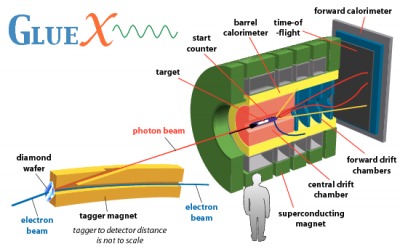 Scientists are one step closer to understanding the strong force that binds quarks together forever. Researchers working with the Continuous Electron Beam Accelerator Facility (CEBAF) at the U.S. Department of Energy’s Jefferson National Accelerator Facility (J-Lab) have published their first scientific results since the accelerator energy was increased from six billion electron volts (GeV) to 12 GeV. The upgrade was commissioned to enable the next generation of physics experiments that will allow scientists to see smaller bits of matter than have ever been seen before. The first publication from the upgraded CEBAF was published by the Gluonic Excitation Project (GlueX) in the April issue of Physical Review C, available online through the APS web site.
Scientists are one step closer to understanding the strong force that binds quarks together forever. Researchers working with the Continuous Electron Beam Accelerator Facility (CEBAF) at the U.S. Department of Energy’s Jefferson National Accelerator Facility (J-Lab) have published their first scientific results since the accelerator energy was increased from six billion electron volts (GeV) to 12 GeV. The upgrade was commissioned to enable the next generation of physics experiments that will allow scientists to see smaller bits of matter than have ever been seen before. The first publication from the upgraded CEBAF was published by the Gluonic Excitation Project (GlueX) in the April issue of Physical Review C, available online through the APS web site.
University of Connecticut Associate Professor of Physics Richard Jones and students have played a leading role in the GlueX experiment since its inception in a series of scientific workshops nearly 20 years ago. The goal of GlueX is to discover whether or not a new class of subatomic particle known as “hybrid mesons” actually exists, and if they do, to measure their masses and other properties. While their existence is widely accepted on the basis of general theoretical arguments, definitive experimental evidence is still lacking. If they exist, hybrid mesons should be much more massive than ordinary mesons, so they should decay into ordinary mesons before they can travel any further than a few femtometers from where they were formed. Hence, the GlueX experiment is equipped with a multi-particle tracking spectrometer with nearly full angular coverage and sensitivity to both charged particles and neutrals.
In this new paper, the GlueX team describes how they produced two ordinary mesons, the neutral pion and eta. While creating these two particles is fairly simple for an accelerator of the CEBAF’s magnitude, what was interesting to the researchers is that they were able to show that the linear polarization of the accelerator’s photon beam can provide enough information about how the meson was formed. They can use that information to narrow down theories about how the mesons were produced. The research team plans to continue to analyze the data the accelerator has produced since it was commissioned a year ago, and they will begin to collect new data this fall.
-based on a news article by Jocelyn Duffy